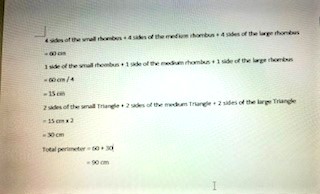Ask Singapore Homework?
Upload a photo of a Singapore homework and someone will email you the solution for free.

Question
primary 6 | Maths
| Measurement
One Answer Below
Anyone can contribute an answer, even non-tutors.

Please assist. The 3 rhombuses are of different sizes but can I divided equally? It doesn't make sense....
Perimeter of all 3 rhombuses
= Perimeter of small rhombus + perimeter of medium rhombus + perimeter of large rhombus
= 4 lengths of small rhombus + 4 lengths of medium rhombus + 4 lengths of large rhombus
Since total perimeter of all 3 rhombuses
= 60cm,
4 lengths of small rhombus + 4 lengths of medium rhombus + 4 lengths of large rhombus = 60cm
1 length of small rhombus + 1 length of medium rhombus + 1 length of large rhombus
= 60cm ÷ 4 = 15cm
We have 3 equilateral triangles, small medium and large.
From the figure we can see that :
Length of 1 side of big triangle = length of 1 side of big rhombus
Length of 1 side of medium triangle = length of 1 side of medium rhombus
Length of 1 side of small triangle = length of 1 side of small rhombus
Perimeter of figure
= 3 sides of each rhombus + 2 sides of each equilateral triangle
= 3 sides of each rhombus + 2 sides of each rhombus
(Because we already established that the sides of the triangles are equal to their corresponding rhombuses)
= 5 sides of each rhombus
= 5 sets of lengths (1 big ,1 medium,1 small rombus length for each set)
= 5 x 15cm
= 75cm
The rhombuses are of different lengths based on their appearance. Though it is possible that they are equal and merely just not drawn to scale, this will have to be mentioned by the question. However there is no mention of this.
We cannot establish their individual lengths as no info is given. And we also have no sure way to determine if they are equal or not.
But we know that we can group their lengths into 4 sets, each set having 1 small, 1 medium and 1 big rhombus length. And 4 sets equals 60cm.
Then 1 set is 15cm.
So we don't need to figure if they are the equal or not, or what each individual length is to solve this question.
Most importantly, never assume they are equal. For this question, assuming so will get you to the same answer of 75cm (you can try) but it's conceptually incorrect.
In other questions, assuming so is most likely to lead to a wrong answer.
Note that the answer is 75cm instead of the 90cm the other person posted as we can only count 3 sides of each rhombus instead of the 4. The inner side is already blocked when you consider the whole figure.
See 1 Answer

I hope it helps.
The inner side is sandwiched by the triangle so it's no longer part of the outline of the figure and thus it cannot be included in the perimeter.
You should only be counting 3 sides of each rhombus.




